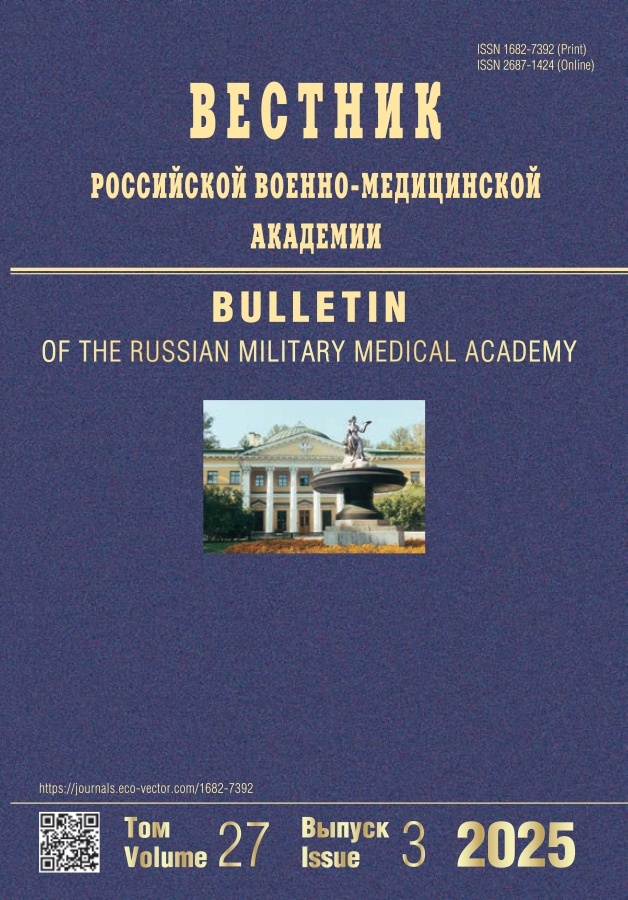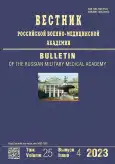Morphometric characteristics of the abdominal surface of the diaphragm for various benefits
- Authors: Prosvetov V.A.1, Gaivoronsy I.V.1,2, Surov D.A.1, Goryacheva I.A.1,2, Panenko P.S.1, Fandeeva O.M.1
-
Affiliations:
- Kirov Military Medical Academy
- Saint Petersburg State University
- Issue: Vol 25, No 4 (2023)
- Pages: 611-618
- Section: Original Study Article
- URL: https://journal-vniispk.ru/1682-7392/article/view/253753
- DOI: https://doi.org/10.17816/brmma473676
- ID: 253753
Cite item
Abstract
The dependence of the regional morphometric characteristics of the abdominal surface of the diaphragm on body shape was evaluated because the information available in the specialized literature on this issue differs significantly. The study was conducted on 30 corpses aged 50–70 years, who were embalmed using a special technology (preserving tissue elasticity, giving the diaphragm a physiological shape with deep exhalation by pumping air into the abdominal cavity). The objects were then frozen, abdominal organs were sequentially removed, and linear dimensions and areas of subdiaphragmatic, subhepatic, and splenic depressions, physiological openings (inferior vena cava, aorta, esophagus, and ligamentous apparatus of the upper floor of the peritoneal cavity), area nuda, diaphragm legs, and lumbar–rib triangles were examined. The results of the analysis of the morphometric parameters revealed significant statistically significant differences in the linear dimensions and areas of the right and left subdiaphragmatic, subhepatic, splenic depressions, and individual parts of the diaphragm in individuals with different body shapes. For these anatomical formations of the peritoneum, the highest values of morphometric parameters are characteristic of the brachymorphic form of the physique, except for the sizes of the lumbar–costal triangles, medial legs, and height of the diaphragm domes, which have the maximum dimensions with a dolichomorphic form. Attention was drawn to the significant differences in the area nuda between extreme forms of physique, which reached 59%. Statistically significant differences were found in the morphometric parameters of the abdominal surface of the diaphragm in mesomorphic and extreme forms of physique; however, they are characterized by smaller values, ranging from 8% to 42% for various parameters. Of particular importance is knowledge of the size of the studied parts of the diaphragm covered by the peritoneum during cytoreductive interventions. Anatomical studies performed on specially embalmed objects with preservation of tissue elasticity and the physiological shape of the diaphragm allow us to obtain its reliable morphometric characteristics.
Full Text
##article.viewOnOriginalSite##About the authors
Vadim A. Prosvetov
Kirov Military Medical Academy
Email: prosvetovvma@yandex.ru
ORCID iD: 0000-0002-5503-1598
SPIN-code: 1717-7735
external co-researcher
Russian Federation, Saint PetersburgIvan V. Gaivoronsy
Kirov Military Medical Academy; Saint Petersburg State University
Email: i.v.gaivoronskiy@mail.ru
ORCID iD: 0000-0002-7232-6419
SPIN-code: 1898-3355
MD, Dr. Sci. (Med.), Professor
Russian Federation, Saint Petersburg; Saint PetersburgDmitry A. Surov
Kirov Military Medical Academy
Author for correspondence.
Email: sda120675@mail.ru
SPIN-code: 5346-1613
MD, Dr. Sci. (Med.), associate Professor
Russian Federation, Saint PetersburgInga A. Goryacheva
Kirov Military Medical Academy; Saint Petersburg State University
Email: nichiporuk120@mail.ru
ORCID iD: 0000-0003-3064-7596
SPIN-code: 6705-8553
MD, Cand. Sci. (Med.)
Russian Federation, Saint Petersburg; Saint PetersburgPavel S. Panenko
Kirov Military Medical Academy
Email: pushercops@mail.ru
SPIN-code: 1035-3261
doctor of medical sciences, Professor
Russian Federation, Saint PetersburgOksana M. Fandeeva
Kirov Military Medical Academy
Email: osteolog_oxana@mail.ru
ORCID iD: 0000-0002-3857-7388
SPIN-code: 8320-9471
doctor of medical sciences
Russian Federation, Saint PetersburgReferences
- Petrovsky BV, Kanshin NN, Nikolaev NO. Khirurgiya diafragmy. Leningrad: Akad. med. Nauka SSSR; 1966. 336 p. (In Russ.).
- Anraku M, Shargall Y. Surgical conditions of the diaphragm: anatomy and physiology. Thorac Surg Clin. 2009:19(4):419–429. doi: 10.1016/j.thorsurg.2009.08.002
- Sugarbaker PH. Prevention and treatment of peritoneal metastases: a comprehensive review. Indian J Surg Oncol. 2019;10(1):3–23. doi: 10.1007/s13193-018-0856-1
- Barakov VYa Diafragma (embriogenez, vozrastnaya, topograficheskaya i funktsional’naya anatomiya). Tashkent: Medicine; 1986. 48 p. (In Russ.).
- Maksimenkov AN. Khirurgicheskaya anatomiya zhivota. Leningrad: Meditsina; 1972. 688 p. (In Russ.).
- Prosvetov VA. Historical aspects of studying the anatomy of the diaphragm. Morphology at the turn of the century In: Materials of the All-Russian Jubilee Scientific Conference dedicated to the 100th anniversary of the birth of the Hero of the Soviet Union, Major General of the Medical Service Professor E.A. Dyskin, Saint Petersburg, January 14, 2023. Saint Petersburg: Military Medical Academy; 2023;140–143. (In Russ.).
- De Leon N, Tse UH, Ameis D. Embryology and anatomy of congenital diaphragmatic hernia. Semin Pediatrician Surgery. 2022:31(6):37–51. doi: 10.1016/j.sempedsurg.2022.151229
- Nucci R, de Souza R, Suemoto S, et al. Muscular structure of the diaphragm in the elderly: results of an autopsy study. Acta Histochem. 2020;122(2):122–124. doi: 10.1016/j.acthis.2019.151487
- Plessi M, Ramai D, Shah S. Clinical anatomy of the musculoskeletal part of the diaphragm. Surgical Radiology. 2015;37(9):1013–1033. doi: 10.1007/s00276-015-1481-0
- Spiliotis J, Kopanakis N, Prodromidou A, et al. Peritoneal sarcomatosis: cytoreductive surgery and hyperthermic intraperitoneal chemotherapy. Surg Innov. 2021;28(3):394–395. doi: 10.1177/1553350620958259
Supplementary files









